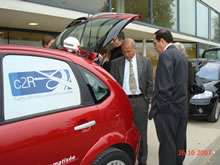Software gets smart cars talking

New technology allowing a group of vehicles to exchange data automatically with each other and with traffic control centres could pave the way for a more efficient and safer European road network.
The Com2React team says their technology could be useful to drivers, traffic police, emergency services and companies with a fleet of vehicles to manage.
The researchers developed a system to help inform drivers of poor weather or road conditions immediately ahead, allowing them to choose alternate routes, easing congestion and cutting down on accidents, says Dr Chanan Gabay, Com2React’s (C2R) project coordinator.
Being able to share such data is a crucial component of any future automated road traffic management system that aims to provide drivers with ‘live’ information en route. Vehicle-to-vehicle (V2V) communication is also key to the vision of the intelligent car, one able to process data and aid drivers.
The EU-funded Com2React project’s main achievement was to develop software that creates a virtual traffic control sub-centre, which temporarily forms to manage a moving group of vehicles in close proximity.
The software assigns the role of the virtual control centre automatically to one of the vehicles in the group according to rules embedded in the C2R software.
“A lot of areas are not covered by regional traffic control centres,” says Gabay. “By creating virtual sub-centres, the system extends the traffic networks to those areas.”
The sub-centre obtains and processes data acquired by the group of vehicles and rapidly provides the driver with instructions related to local traffic and safety situations.
The software also transmits selective data to a regional control centre and receives current traffic information to distribute to the vehicles. The updated ‘common knowledge’ is then processed by each vehicle’s software, allowing drivers to make informed decisions.
Local information processed locally
The concept works as information processed through the virtual sub-centre can be better directed to the relevant vehicles, avoiding information overload, says Gabay.
“Local communication is much faster than remote communication and can, therefore, enable an immediate reaction to sudden events,” he adds.
The challenge for the C2R research team was to develop software able to handle a large amount of relevant shared information intelligently. The resulting system is made up of software linked through a series of sensors.
The software is designed to handle safety alerts, link into a vehicle’s navigation system by providing real-time traffic information, and organise the data according to an individual driver’s needs.
And a prototype system, tested in Munich and Paris last summer, proves that it works. “We showed that the conceptual part of vehicle-to-vehicle communications can be done.”
Now, the team is looking for further funding to bring down the cost of the system to about €100 a vehicle before it can be accepted by vehicle manufacturers and commercialised. Currently, the system costs “thousands” of euros, he says.
The regulation and harmonisation of V2V communications could also pose another obstacle to the technology, he believes.
The Com2React team is holding seminars with ministers of transport from Israel and with the European Commission in a bid to develop the concept further.
The team is made up of researchers from Motorola, Arttic, Transver, the Technical University of Munich, INRIA, Armines-Ecole des Mines, Everis, Intempora, Telefonica, Sphericon, PSA (Peugeot Citroen), Navteq and the Jerusalem Transportation authorities.
Peugeot is interested in the technology, according to Gabay, but is waiting until the costs are brought down first. Israel’s government is also considering the technology, says Gabay. Another team member is promoting the technology in Spain.'
Their business plan forecasts that the concept and technology could be profitable after three years.
“It is a real breakthrough,” says Gabay. “As far as is known, no distributed programmes are underway in a peer-to-peer mode on top of an ad hoc network implementing a concrete traffic application.”
Source:





















